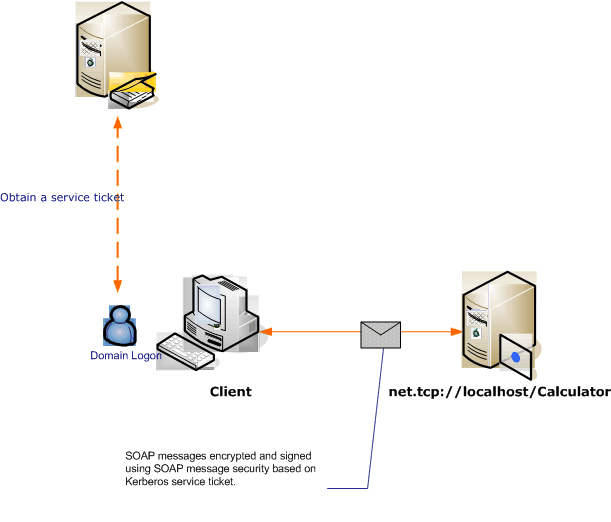以下方案显示了由 Kerberos 协议保护的 Windows Communication Foundation (WCF) 客户端和服务。
服务和客户端都位于同一域或受信任的域中。
注释
此方案与 Windows 客户端的消息安全性 之间的区别在于,在发送应用程序消息之前,此方案不会与服务协商服务凭据。 此外,由于这需要 Kerberos 协议,因此此方案需要 Windows 域环境。

| 特征 | DESCRIPTION |
|---|---|
| 安全模式 | 消息 |
| 互操作性 | 是,WS-Security 使用 Kerberos 令牌配置文件兼容的客户端 |
| 身份验证(服务器) | 服务器和客户端的相互身份验证 |
| 身份验证(客户端) | 服务器和客户端的相互身份验证 |
| 完整性 | 是的 |
| 机密性 | 是的 |
| 运输 | HTTP |
| 捆绑 | WSHttpBinding |
服务
下面的代码和配置应独立运行。 执行下列操作之一:
使用代码(而不使用配置)创建独立服务。
使用提供的配置创建服务,但不定义任何终结点。
代码
以下代码创建使用消息安全性的服务终结点。 该代码禁用服务凭据协商和安全上下文令牌(SCT)的建立。
注释
若要使用没有协商的 Windows 凭据类型,则服务的用户帐户必须能够访问在 Active Directory 域注册的服务主体名称 (SPN)。 可通过两种方式实现此目的:
使用
NetworkService帐户或LocalSystem帐户来运行服务。 由于这些帐户有权访问计算机加入 Active Directory 域时建立的计算机 SPN,因此 WCF 会在服务的元数据(Web 服务描述语言或 WSDL)中自动生成服务终结点内的适当 SPN 元素。使用任意 Active Directory 域帐户运行服务。 在这种情况下,需要为该域帐户建立 SPN。 执行此作的一种方法是使用 Setspn.exe 实用工具工具。 为服务的帐户创建 SPN 后,请将 WCF 配置为通过其元数据(WSDL)将该 SPN 发布到服务的客户端。 设置公开终结点的标识可以通过两种方式完成:应用程序配置文件或代码。 以下示例以编程方式发布标识。
有关 SPN、Kerberos 协议和 Active Directory 的详细信息,请参阅 适用于 Windows 的 Kerberos 技术补充。 有关终结点标识的详细信息,请参阅 SecurityBindingElement 身份验证模式。
// Create the service host.
ServiceHost myServiceHost = new ServiceHost(typeof(Calculator));
// Create the binding.
WSHttpBinding binding = new WSHttpBinding();
binding.Security.Mode = SecurityMode.Message;
binding.Security.Message.ClientCredentialType =
MessageCredentialType.Windows;
// Disable credential negotiation and establishment of the
// security context.
binding.Security.Message.NegotiateServiceCredential = false;
binding.Security.Message.EstablishSecurityContext = false;
// Create a URI for the endpoint address.
Uri httpUri = new Uri("http://localhost/Calculator");
// Create the EndpointAddress with the SPN for the Identity.
EndpointAddress ea = new EndpointAddress(httpUri,
EndpointIdentity.CreateSpnIdentity("service_spn_name"));
// Get the contract from the ICalculator interface (not shown here).
// See the sample applications for an example of the ICalculator.
ContractDescription contract = ContractDescription.GetContract(
typeof(ICalculator));
// Create a new ServiceEndpoint.
ServiceEndpoint se = new ServiceEndpoint(contract, binding, ea);
// Add the service endpoint to the service.
myServiceHost.Description.Endpoints.Add(se);
// Open the service.
myServiceHost.Open();
Console.WriteLine("Listening...");
Console.ReadLine();
// Close the service.
myServiceHost.Close();
' Create the service host.
Dim myServiceHost As New ServiceHost(GetType(ServiceModel.Calculator))
' Create the binding.
Dim binding As New WSHttpBinding()
binding.Security.Mode = SecurityMode.Message
binding.Security.Message.ClientCredentialType = _
MessageCredentialType.Windows
' Disable credential negotiation and establishment of the
' security context.
binding.Security.Message.NegotiateServiceCredential = False
binding.Security.Message.EstablishSecurityContext = False
' Create a URI for the endpoint address.
Dim httpUri As New Uri("http://localhost/Calculator")
' Create the EndpointAddress with the SPN for the Identity.
Dim ea As New EndpointAddress(httpUri, _
EndpointIdentity.CreateSpnIdentity("service_spn_name"))
' Get the contract from the ICalculator interface (not shown here).
' See the sample applications for an example of the ICalculator.
Dim contract As ContractDescription = ContractDescription.GetContract(GetType(ICalculator))
' Create a new ServiceEndpoint.
Dim se As New ServiceEndpoint(contract, binding, ea)
' Add the service endpoint to the service.
myServiceHost.Description.Endpoints.Add(se)
' Open the service.
myServiceHost.Open()
Console.WriteLine("Listening...")
Console.ReadLine()
' Close the service.
myServiceHost.Close()
配置
以下配置可代替代码使用。
<?xml version="1.0" encoding="utf-8"?>
<configuration>
<system.serviceModel>
<behaviors />
<services>
<service behaviorConfiguration="" name="ServiceModel.Calculator">
<endpoint address="http://localhost/Calculator"
binding="wsHttpBinding"
bindingConfiguration="KerberosBinding"
name="WSHttpBinding_ICalculator"
contract="ServiceModel.ICalculator"
listenUri="net.tcp://localhost/metadata" >
<identity>
<servicePrincipalName value="service_spn_name" />
</identity>
</endpoint>
</service>
</services>
<bindings>
<wsHttpBinding>
<binding name="KerberosBinding">
<security>
<message negotiateServiceCredential="false"
establishSecurityContext="false" />
</security>
</binding>
</wsHttpBinding>
</bindings>
<client />
</system.serviceModel>
</configuration>
客户
下面的代码和配置应独立运行。 执行下列操作之一:
使用代码(和客户端代码)创建独立客户端。
创建不定义任何终结点地址的客户端。 而使用将配置名称作为自变量的客户端构造函数。 例如:
CalculatorClient cc = new CalculatorClient("EndpointConfigurationName");Dim cc As New CalculatorClient("EndpointConfigurationName")
代码
以下代码配置客户端。 安全模式设置为消息,客户端凭据类型设置为 Windows。 请注意,属性NegotiateServiceCredentialEstablishSecurityContext设置为 false.
注释
若要在不协商的情况下使用 Windows 凭据类型,必须在开始与服务通信之前使用服务的帐户 SPN 配置客户端。 客户端使用 SPN 获取 Kerberos 令牌,以进行身份验证和保护与服务的通信。 以下示例演示如何使用服务的 SPN 配置客户端。 如果使用 ServiceModel 元数据实用工具工具(Svcutil.exe) 生成客户端,则服务的 SPN 将自动从服务的元数据(WSDL)传播到客户端(如果服务的元数据包含该信息)。 有关如何将服务配置为在服务的元数据中包含其 SPN 的详细信息,请参阅本主题后面的“服务”部分。
有关 SPN、Kerberos 和 Active Directory 的详细信息,请参阅 适用于 Windows 的 Kerberos 技术补充。 有关终结点标识的详细信息,请参阅 SecurityBindingElement 身份验证模式 主题。
// Create the binding.
WSHttpBinding myBinding = new WSHttpBinding();
myBinding.Security.Mode = SecurityMode.Message;
myBinding.Security.Message.ClientCredentialType =
MessageCredentialType.Windows;
// Disable credential negotiation and the establishment of
// a security context.
myBinding.Security.Message.NegotiateServiceCredential = false;
myBinding.Security.Message.EstablishSecurityContext = false;
// Create the endpoint address and set the SPN identity.
// The SPN must match the identity of the service's SPN.
// If using SvcUtil to generate a configuration file, the SPN
// will be published as the <servicePrincipalName> element under the
// <identity> element.
EndpointAddress ea = new EndpointAddress(
new Uri("http://machineName/Calculator"),
EndpointIdentity.CreateSpnIdentity("service_spn_name"));
// Create the client.
CalculatorClient cc =
new CalculatorClient(myBinding, ea);
// Begin using the client.
try
{
cc.Open();
Console.WriteLine(cc.Add(200, 1111));
Console.ReadLine();
// Close the client.
cc.Close();
}
' Create the binding.
Dim myBinding As New WSHttpBinding()
myBinding.Security.Mode = SecurityMode.Message
myBinding.Security.Message.ClientCredentialType = _
MessageCredentialType.Windows
' Disable credential negotiation and the establishment of
' a security context.
myBinding.Security.Message.NegotiateServiceCredential = False
myBinding.Security.Message.EstablishSecurityContext = False
' Create the endpoint address and set the SPN identity.
' The SPN must match the identity of the service's SPN.
' If using SvcUtil to generate a configuration file, the SPN
' will be published as the <servicePrincipalName> element under the
' <identity> element.
Dim ea As New EndpointAddress(New Uri("http://machineName/calculator"), _
EndpointIdentity.CreateSpnIdentity("service_spn_name"))
' Create the client.
Dim cc As New CalculatorClient(myBinding, ea)
' Begin using the client.
Try
cc.Open()
Console.WriteLine(cc.Add(100, 11))
Console.ReadLine()
' Close the client.
cc.Close()
Catch tex As TimeoutException
Console.WriteLine(tex.Message)
cc.Abort()
Catch cex As CommunicationException
Console.WriteLine(cex.Message)
cc.Abort()
Finally
Console.WriteLine("Closed the client")
Console.ReadLine()
End Try
配置
以下代码配置客户端。 请注意,必须将 <servicePrincipalName> 元素设置为与服务的 SPN 相匹配,该 SPN 是在 Active Directory 域中为服务帐户注册的。
<?xml version="1.0" encoding="utf-8"?>
<configuration>
<system.serviceModel>
<bindings>
<wsHttpBinding>
<binding name="WSHttpBinding_ICalculator" >
<security mode="Message">
<message clientCredentialType="Windows"
negotiateServiceCredential="false"
establishSecurityContext="false" />
</security>
</binding>
</wsHttpBinding>
</bindings>
<client>
<endpoint address="http://localhost/Calculator"
binding="wsHttpBinding"
bindingConfiguration="WSHttpBinding_ICalculator"
contract="ICalculator"
name="WSHttpBinding_ICalculator">
<identity>
<servicePrincipalName value="service_spn_name" />
</identity>
</endpoint>
</client>
</system.serviceModel>
</configuration>